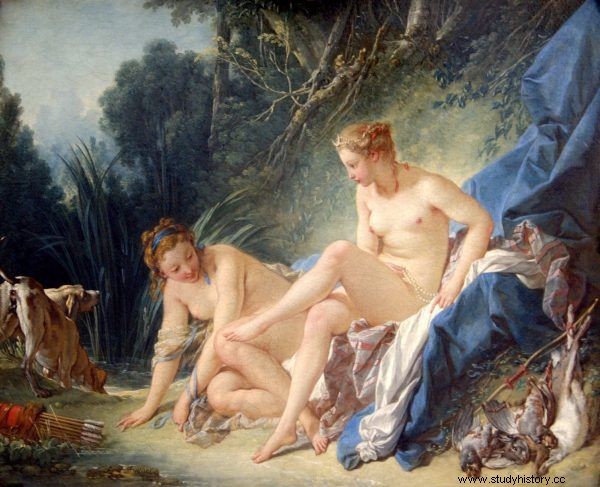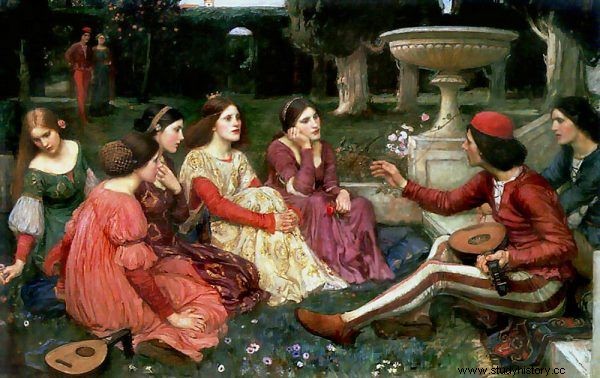An era of quiet sighs, shameful desires and boring fantasies? None of these things. Even people of the 21st century might be in a hurry reading erotic stories from before a quarter of a millennium. Would you also blush?
Giacomo Casanova made history with his descriptions of his love conquests. His diaries known under the title "The History of My Life" are colorful descriptions of 18th-century sexual customs in various parts of Europe. They entered the canon of erotic literature. The famous libertine, however, had tough competition in this area.
Casanova was in every way a child of his era. An ambitious erudite and polyglot, well versed in intellectual trends, being up to date with literature and art, he certainly had on his shelf the most important books that in the eighteenth century a man had to know about his aspirations.
Especially since the time of the Regency (1715-1723), an era famous for moral licentiousness, libertine literature - quantitatively speaking - took first place among the genres published in France, and also in French outside this country.
Intellectualized eroticism
Anyway, the libertine attitude meant not only bodily pleasures but also a certain intellectual and worldview attitude - which was reflected in the writing. As Jerzy Łojek writes:
Libertine fiction moves from "pure" to "philosophical" eroticism. It is anti-church and antifideistic, which gives it a special field of possibilities, including in the field of descriptive realism in presenting sexual practices. He introduces the physiology and then the pathology of sex to the pages of novels or dialogues, often associating it with an ironic, sarcastic mockery of holiness and "purity" (...), of the relationship between the "spiritual director" and the young devotee.

Some erotic writers did not admit to this type of writing and suggested that it was done by women. In the painting "Diana Coming Out of the Bath" by François Baucher.
It strikes at the foundations of Christian morality, propagating the view that the source of all ethical systems is a social convention, that there are no revealed or natural moral principles, that the value of all moral recommendations - primarily everything in the field of erotic morality - it is relative.
One of the progenitors of such thinking was Nicolaspost Chorier (1612-1693), a lawyer from Provence and later the royal prosecutor in Grenoble, who became famous for his monumental trial entitled "The Story of the Dolphin" (1661).
None of the serious government officials even assumed that Chorier was also the author of a book with erotic content in Latin, published in Lyon in 1659. Admittedly, its title sounds quite serious from our perspective:" Aloysiae Sigeae Toletanae Satyra Sotadica de Arcanis Amoris et Veneris ”, The content remains very spicy though.
Before the Marquis de Sade
Chorier himself, not wanting to reveal himself, assigned the authorship of the volume to the Spanish-Portuguese humanist Aloysia Sigei (born around 1530), and the translation to Jan Meursius, a Dutch scholar and antiquarian living at the turn of the 16th and 17th centuries.
Chorier's book became famous mainly due to the descriptions of the physiology of "amorous intimacy", which went against the sentimental trends that were still in force at that time. He described sexual practices, sometimes very drastic.
Today it is recognized that until the time of the Marquis de Sade, no one in France had described sexual intercourse as sharply and boldly as Chorier. By the eighteenth century, his volume had more than one hundred editions. and it has become both compulsory and secret reading for enlightened classes throughout Europe.
But Chorier, of course, had his masters. He was definitely reading a collection of one hundred novellas by Giovanni Boccaccio , created in the mid-fourteenth century and collected in the "Decameron" (in 1559 the volume was entered by the papacy into the index of forbidden books). These stories of noble brides and young men who escaped the plague somewhere near Florence are full of blunt sexuality, in which priests, nuns, and especially hermits lead the way (the short story "The Devil and Hell" deserves special attention). Anyway, "The Decameron" does not lose its relevance even today - in 1971 it was screened by Pier Paolo Pasolini himself.

The inhabitants of Renaissance Florence played with spicy stories to forget about the plague. Boccaccio's “The Decameron” tells about it. Pictured is a painting by John William Waterhouse.
Father of pornographic literature
Chorier's work was certainly inspired by the works of Pietro Aretin , an outstanding Renaissance intellectual who, as the papal chronicler, knew well the atmosphere of the Roman Curia. He wrote deeply religious works, as well as sharp satires and political lampoons, for which he is sometimes called "the whip of princes". At the same time, however, he is considered the father of pornographic literature.
And this is due to his "Ragionamenti" and "Lives of Courtesans", i.e. dialogues describing the lives of women of not the most severe morals. Aretino was not afraid to write about what courtesans were sometimes forced to do, or rather how far they were willing to go in the bedroom to wrap a man. He shows them as intelligent, cunning women who often chose such a life to break out of the social schema, thus manifesting the "power of the weak sex".
Aretino also left behind many overtly erotic aphorisms. Here are some of them:
When the hand after the sacred rump of the drum, this music is stronger than the playing of flutists at the papal court.
The sins of the courtesan are, in a way, her virtues as well.
Fucking craftsmanship is not a profession for a stupid person, it is not enough to tear up your dresses and say - driving.
The trick is not to get lovers, but to keep them with you.
In the palace chambers and monastery refectories, libertines organized orgies - often very brutal. The photo shows an illustration for the book of the Marquis de Sade entitled "Justyna or the Miseries of Virtue" from 1797.
Giacomo Casanova must have known the works of Aretino. Laurence Bergreen's book Casanova. In the world of the seducer. As the author of this biography emphasizes, the work of the Renaissance author was for the Enlightenment seducer not only entertainment, but also an important textbook of love art.
Sex in the monastery walls
The erotic literature of the 18th century was served by the moral scandals of the epoch, which quickly became a pretext for writers. This was the case, for example, with the scandal of Father Girard and Katarzyna Cadière. It is their story that is described in " Thérèse Philosophe ”(The author is probably the Marquess of d'Argens ), where the heroes of this authentic story are hidden under the pseudonyms Dirrag and Eradice. The main character, a virtuous virgin, is led astray by her spiritual guide.
Sexual practices taking place within the walls of French monasteries became the basis for the story of Jean-Charles Gervaise de Latouche " Histoire de Dom Bougre, Portier des Chartreux ". There are many descriptions of the most sophisticated erotic games that "would not be ashamed of and courtesans". But this is perhaps not surprising, considering that in France or the Netherlands, monasteries often housed printing houses for illegal libertine books.
The author's personal experiences are recorded in the books of the Marquis Donatien-Alphonsa-François de Sade , the most brutal testimonies of libertine hedonism, dazzling with violence, rape and the pleasure of inflicting pain. The longest orgy in which this aristocrat most certainly participated was in 1757 and lasted one hundred and twenty days. He poisoned four prostitutes who were given a poorly prepared aphrodisiac. One of his maids, badly injured during the sexual games she was forced into, fled the marquess's mansion, notifying the authorities.
All this is echoed in the "One Hundred and Twenty Days of Sodom" or "Justina, or the Sorrows of Virtue" written by the Marquis de Sade. Indeed, Casanova is innocent compared to him.
Literature is always alive
Fortunately, sex was also written with humor and distance. It is worth mentioning here the work of Crébillonasyna with his " Sofie " "As well as" Playing the corner by the fireplace ". These are satirical, quite funny documents of the epoch, the task of which is not to overturn the moral system, but the chronicle of the epoch.
In this context - by contrast - it is certainly worth mentioning the "Maid of Orleans" Voltaire , an author whom Casanova felt great respect for. It was a rather frivolous story about Joan of Arc, the national heroine of France. It is not only erotic entertainment, but also building an anti-myth, because in this case we are dealing with a character "serving in an inn, the daughter of a dissolute monk, liberating Orleans on a donkey and after being released from the vows of chastity devoted to the joys of life".

Enlightenment libertines are still popular books. Pierre Choderlos de Laclos' Dangerous Liaisons have had several adaptations.
Books of the 18th century libertines are still being reprinted. They also enjoy the constant interest of readers, which in the times of ubiquitous Internet testifies well to their viability. There has even been a ranking of the most popular items of this genre on the French Internet.
Interestingly, there was a book entitled " Pauliska ou La Perversité moderne:mémoires récents d'une Polonaise " Jacques Antoine Révé . Polka, the heroine of the French erotic book of the Age of Lights? What would Casanova, who in Poland preferred libraries over women, say to this?
